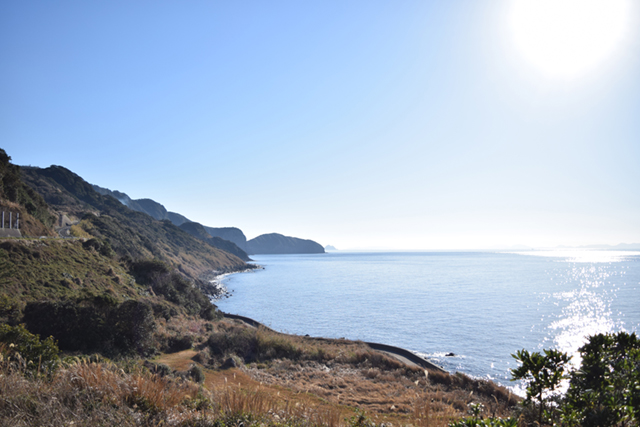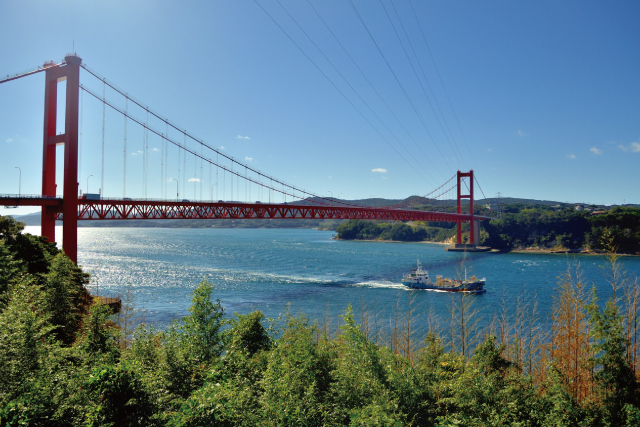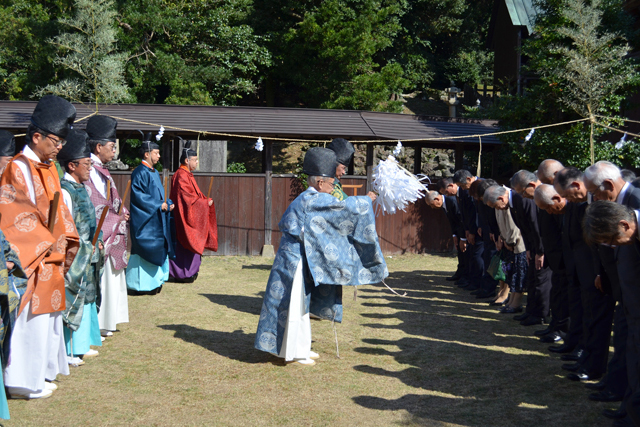The Introduction of Rice Cultivation
The city of Hirado in Nagasaki Prefecture, located in the westernmost part of Kyushu, has been actively engaged in exchange via the sea.
In Hirado, there are remains and historical documents everywhere that indicate that there was long-standing exchange with foreign countries.
 Rice fields at the Satotabaru archeological site
Rice fields at the Satotabaru archeological site
 Rice cultivation is still practiced today
Rice cultivation is still practiced today
The Satotabaru archeological site contains remains that indicate that rice cultivation was introduced from mainland China in ancient times.
Many wooden products used in rice cultivation have been excavated from the paddy fields, and some of them are on display in the lobby of the Hirado City Hall Tabira Branch Office.
Behind the Tabira Branch Office, there are a lot of paddy fields divided into squares, which is thought to be a remnant of the “Jori” system of land subdivision in ancient Japan.
 Wooden products displayed in the lobby of the Tabira Branch Office
Wooden products displayed in the lobby of the Tabira Branch Office
 A type of tomb called Shisekibo at the Satotabaru archeological site
A type of tomb called Shisekibo at the Satotabaru archeological site
At Satotabaru, burial mounds were also found that are said to have been introduced from the Korean Peninsula in the Jomon period before the common era, indicating that along with rice cultivation, various other cultural influences came to Japan from the continent.
Exchange with China
From the 7th century onward, the Japanese Imperial Court sent emissaries to exchange with the Chinese dynasties.
It was around this time (804 AD) that Kukai, a famous Japanese monk, traveled to the Asian continent.
A stone statue of Kukai was erected at Tanoura in Hirado where he is said to have left Japan from.
The large stone statue of Kukai, his clothes fluttering in the wind as he points across the sea to the Chinese continent, is one of the largest in Japan, standing 16 meters high, including the base.
 The 16-meter high statue of Kukai
The 16-meter high statue of Kukai
 The approach to the statue of Kukai
The approach to the statue of Kukai
From the 9th century onward, shipping routes from Japan to mainland China, which had previously traveled northward along the Korean Peninsula from northern Kyushu, began to use direct routes from Hakata to China via Hirado and Goto, making Hirado an important transit point for people, goods, and cultures.
Many different cultures started to flow into the Hirado area.
Eisai, the monk who brought Zen and Tea to Japan
 Former site of Fushun-an Temple
Former site of Fushun-an Temple
Eisai, a monk who mastered the Rinzai style of Zen Buddhism in China during the Song Dynasty, returned to Japan in 1191 and is said to have first introduced Zen meditation (a state in which the mind is free from disturbance) to Japan at the Fushun-an Temple in Hirado.
At the site of the former Fushun-an Temple, there remains a stone called "the Zen Rock" on which Eisai is said to have practiced the first Zen meditation in Japan.
It is also said that he planted tea seeds here which he had brought back from China.
 Fushun-an Tea Plantation
Fushun-an Tea Plantation
 The Zen Rock where Eisai is said to have sat in meditation
The Zen Rock where Eisai is said to have sat in meditation
16th century: Many Chinese merchants come to trade
 Ruins of the Wang Zhi's mansion
Ruins of the Wang Zhi's mansion
In the 16th century, many Chinese maritime merchants came to Japan in search of silver.
In 1541, the influential Chinese maritime merchant Wang Zhi established his base in Hirado and prospered there.
The site of his mansion still remains today.
After that, maritime merchants such as Zheng Zhilong continued to use Hirado as a base of operations, and the Dutch trading post was able to obtain raw silk and other commodities for the Japanese market on a steady basis through them.
Zheng Chenggong, a hero who later liberated Taiwan from Dutch rule, was born in Hirado as the son of Zheng Zhilong and a local Japanese woman. You can still find a stone where he is said to have been born at.
The Zheng Chenggong Memorial Hall, which is modeled after the house where Zheng Chenggong was born, exhibits historical documents that show the connection with China.
 Zheng Chenggong Memorial Hall
Zheng Chenggong Memorial Hall
 Volunteer staff can give you a free guided tour!
Volunteer staff can give you a free guided tour!
 Exhibits at the Zheng Chenggong Memorial Hall
Exhibits at the Zheng Chenggong Memorial Hall
Exchange with the West
 Francisco Xavier Monument
Francisco Xavier Monument
In 1550, Portuguese ships arrived in Hirado and trade with the West began, and with it came Christianity.
 Terraced rice paddies of Kasuga
Terraced rice paddies of Kasuga
Various cultural ideas and beliefs were introduced through the trade with the West. Via the port of Hirado they spread to the surrounding areas and took hold. Some of these ideas and beliefs have been handed down to the present day.
Flourishing Trade with the Netherlands
 Grave of William Adams
Grave of William Adams
In 1609, Dutch ships arrived in Japan and the Hirado Dutch Trading Post was established.
The trade activities of the Hirado Dutch Trading Post gradually increased, not the least thanks to the efforts of William Adams, and eventually the trade between Hirado and other parts of Southeast Asia, in particular Taiwan, flourished greatly.
 Saiwai Bridge (Important Cultural Property)
Saiwai Bridge (Important Cultural Property)
 Saiwai Bridge is also known as Dutch Bridge
Saiwai Bridge is also known as Dutch Bridge
In addition to the trading post, stone structures such as the Saiwai Bridge and anchor stones, the Hidden Christian’s unique faith, valuable historical artifacts at the Matsura Historical Museum, and the heritage sites around the Hirado Dutch Trading Post are all evidence of Hirado's long history of exchange with overseas countries.
 Iron anchors of Dutch ships and anchor stones of Chinese ships
Iron anchors of Dutch ships and anchor stones of Chinese ships
Hirado Dutch Trading Post
Built in 1639, the massive stone warehouse was one of the first Western structures built in Japan, with a huge timber structure with pillars measuring approximately 50 cm2.
This stone warehouse was restored almost four centuries later and has now once again become the symbol of Hirado Port as the Hirado Dutch Trading Post museum.
Inside the museum, you can see valuable historical documents that reveal the history of exchange between Hirado and the Netherlands.
 Exhibits at the Hirado Dutch Trading Post
Exhibits at the Hirado Dutch Trading Post
 Exhibits at the Hirado Dutch Trading Post
Exhibits at the Hirado Dutch Trading Post
 Hirado Dutch Trading Post
Hirado Dutch Trading Post
As you visit each spot, seeing the traces of those days and feeling the special atmosphere yourself, you will feel as if you are traveling through time, tracing the history of Hirado one era by one.
Why not tour around Hirado’s historical sites as if you were turning the pages of its long history at each place?

